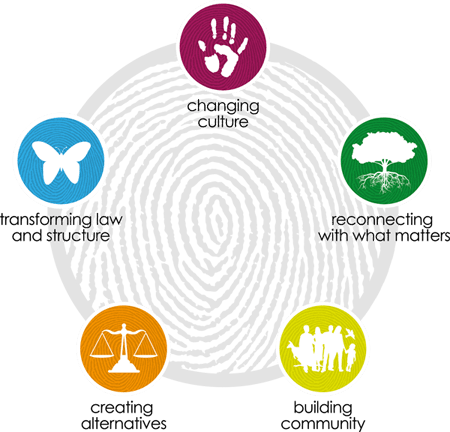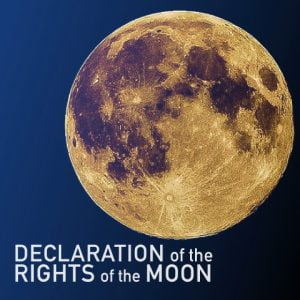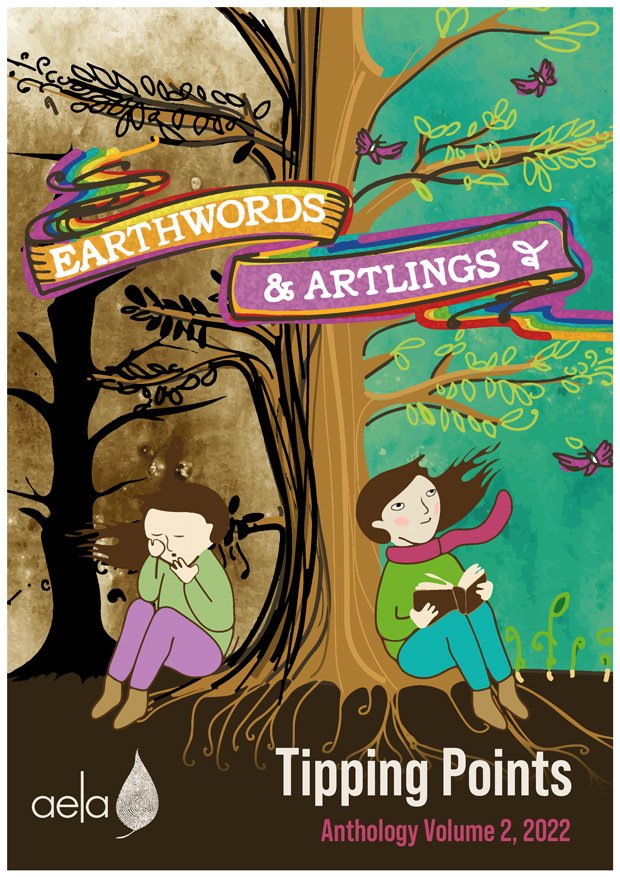- What are Rights of Nature?
- Learning from First Nations Peoples - Earth-centred culture and laws that respect the rights of nature
- Challenging the idea that nature is 'property'
- How are Rights of Nature laws different to current environmental laws?
- Which countries have Rights of Nature laws?
- International statements and networks that recognise the Rights of Nature
- Rights of Nature Tribunals
- How could Rights of Nature laws work in Australia?
- Rights of Nature laws for the Great Barrier Reef
- Further reading
Summary
The Rights of Nature movement is growing world wide. Recognising the Rights of Nature in law, means that we reject the notion that nature is human property and we legally recognise the rights of the natural world to exist, thrive and evolve. Recognising that the natural world is just as entitled to exist and evolve as we are, necessarily changes the way humans act.
Rights of Nature is grounded in the recognition that humanity is just one member of the wider Earth community, and that we have evolved with, and are dependent upon, a healthy, interconnected web of life on Earth. Rights of Nature laws create guidance for actions that respect this relationship.
AELA is working with the International Center for the Rights of Nature, managed by the Community Environmental Legal Defense Fund (CELDF), to advocate for Rights of Nature laws in Australia.
What are Rights of Nature?
The health of ecological communities around the world is deteriorating. The United Nations has warned that we are heading toward "major planetary catastrophe." There is a growing recognition that we must fundamentally change the relationship between humankind and the natural world.
Making this fundamental shift means recognizing our dependence on nature and respecting our need to live in harmony with the natural world. It also means securing the highest legal protection for ecological health.
Acknowledging that all life on Earth has a right to exist, thrive and evolve
Advocates for the Rights of Nature argue that as all life on earth - and life supporting ecosystems - have evolved together during the long history of the universe and the planet, and as human beings are just one part of this larger, interconnected web of life (and are completely interdependent on the rest of the natural world for our very existence), the non-human world has just as much right to exist as humans do. Or, using the language of Earth advocates: the Earth community should be recognised as having the right to exist, thrive and continue its evolutionary journey into the future.
Valuing and protecting nature for its inherent worth
From this view, nature deserves to be valued for its own inherent worth. Legally recognising the rights of nature is not about ‘conferring rights’ on nature, but giving legal recognition to what is already there. Recognising that the natural world is just as entitled to exist and evolve as we are, necessarily changes the way humans act. We can refer to Earth-centred cultures around the world for guidance as to how humans treat the natural world when they see themselves as merely part of it – rather than the masters of it. Many indigenous cultures see plants and animals as relatives, members of an inter-connected community of life that is self-sustaining and deserves respect. They draw from the natural world to live, but do not take more than the natural system can sustainably provide. This contrasts with the culture and legal system that is dominant in western industrialised nations today, which treats plants, animals and entire ecosystems, as objects that are human property. Our current legal system allows humans to destroy ecosystems in the name of material ‘development’ and only grants rights to humans and human-created constructs such as corporations and nation-states.
Legally recognising the rights of nature has a number of significant flow-on effects. In simple terms, it does two things: first, it pro-actively changes the way humans interact with and impact upon the non-human world and second, it changes the way citizens can defend and restore nature.
Learning from First Nations People - Earth centred culture and laws that respect the rights of nature
The Rights of Nature movement acknowledges, respects and is inspired by the ancient wisdom of First Nations peoples around the world.
AELA acknowledges that the sovereignty of the First Nations people of the continent now known as Australia was never ceded by treaty nor in any other way. AELA and the Australian Rights of Nature Tribunal proceedings acknowledge and respect First Nations peoples’ laws and ecologically sustainable custodianship of Australia over tens of thousands of years through land and sea management practices that continue today.
Challenging the idea that nature is ‘property’
Under the current system of law in western and industrialised nations, nature is legally treated as human property. Something that is considered property confers upon the property owner the right to damage or destroy it. Thus, those who “own” wetlands, forests, and other ecosystems and natural communities, are often permitted to use them however they wish, even if that includes destroying the health and well-being of nature. When we talk about the Rights of Nature, it means recognizing that ecosystems and natural communities are not merely property that can be owned. Rather, they are entities that have an independent and inalienable right to exist and flourish. Laws recognizing the Rights of Nature change the status of ecosystems and natural communities to being recognized as rights-bearing entities. As such, they have rights that can be enforced by people, governments, and communities on behalf of nature.
Rights of Nature laws prohibit human activities that would interfere with the ability and rights of ecosystems and natural communities to exist and flourish. These laws transform the status of nature from being regarded as property to being rights-bearing.
In fact, these laws change the status of property law. Rights of Nature laws eliminate the authority of a property owner to interfere with the functioning of ecosystems and natural communities that depend upon that property for their existence. They do not stop development; rather, they stop development and use of property that interferes with the existence and vitality of those ecosystems.
Under Rights of Nature laws:
- Nature is empowered to defend and enforce its own rights;
- People are empowered to defend and enforce the Rights of Nature; and
- Governments are required to implement, defend, and enforce the Rights of Nature.
How are Rights of Nature laws different to current environmental laws?
Current environmental regulatory structures are mostly about “permitting” human centred, material development at the cost of allowing harm to occur to the natural world. For example, our current legal system allows unconventional gas/fracking, mining, logging and factory farming to destroy ecosystems and communities of plants and animals. They act more to legalize the harmful activities of corporations and other business entities than to protect our natural and human communities.
Laws recognizing the Rights of Nature are different. They establish a basic principle of rights for the non-human world, which requires laws and regulations to work within that framework to uphold those rights. In turn, Rights of Nature laws create duties requiring people to consider, defend and speak on behalf of, the non-human world. For example, communities that have enacted Rights of Nature laws in the USA are empowered - indeed, they have a duty - to reject governmental actions permitting unwanted and damaging development which would violate nature's rights to exist and thrive. Rights of Nature laws enable people, communities, and ecosystems themselves to defend and enforce such rights. Without the ability to do so, those ecosystems would be destroyed.
What rights do Rights of Nature laws recognize?
The earliest Rights of Nature laws recognized the right of ecosystems to “exist and flourish.” Others, including the Ecuadorian constitutional provisions promulgated in 2008, recognize the right of nature to exist, persist, evolve, and regenerate. These laws also recognize the right of any person or organization to defend, protect, and enforce those rights on behalf of nature, and for payment of recovered damages to government to provide for the full restoration of nature.
Rights of Nature laws put the health of the natural world at the centre of human decision making
The simplest way to understand the different framework that Rights of Nature laws offer, is that they aim to change human interaction with the natural world. Rights of Nature laws enable the non-human world to be 'seen' in the eyes of the law and to 'have a voice', rather than to be invisible or secondary to human centred objectives.
When we talk about the Rights of Nature, it means recognizing that ecosystems and natural communities are not merely property that can be owned. Rather, they are entities that have an independent and inalienable right to exist and flourish.
Does recognising the Rights of Nature stop human activity?
No, it doesn't. But we do need to rethink some of our activities - and industrial societies need to rethink our attitude about what we can demand from our finite planet.
Recognizing Rights of Nature does not put an end to human activities, rather it places them in the context of a healthy relationship where our actions do not threaten the balance of the system upon which we depend. Further, these laws do not stop all development, they halt only those uses of land that interfere with the very existence and vitality of the ecosystems which depend upon them.
Which countries have Rights of Nature laws?
Rights of nature laws and policies now exist in several countries. The rights of nature were enshrined in Ecuador’s 2008 Constitution, Bolivia’s 2010 ‘Rights of Mother Earth’ Act and are now present in more than three dozen local laws in the USA. In New Zealand, several ecosystems now have legal rights, including the Whanganui River and the Urewera Forest.
The European Citizen’s Initiative on the Rights of Nature is working to introduce a proposed Directive to recognise and enforce the Rights of Nature, and Rights of Nature policies have been adopted by the Scottish Greens Party and the Green Party of England and Wales.
Please click on the links below for information about rights of nature laws and policies around the world.
RIGHTS OF NATURE LAWS
Rights of nature laws exist in the countries listed below. For a brief summary of Rights of Nature laws in all these countries, please read the latest 'Rights of Nature - Global Update Report' from GARN:
- Bangladesh
- Bolivia
- Colombia
- Ecuador
- India
- Mexico City
- New Zealand
- Uganda
- USA
- Ho Chunk Tribal Council
- Ponca Tribal Council
- USA - local community ordinances
RIGHTS OF NATURE POLICIES AND ADVOCACY
- EU Directive on the Rights of Nature - proposed Citizen's Initiative
- Greens Party of Scotland - official adoption of Rights of Nature policy
- Green Party of England and Wales - official adoption of Rights of Nature policy
International and Regional Initiatives
- Universal Declaration for the Rights of Mother Earth
- UN Harmony with Nature Initiative
- IUCN (International Union for the Conservation of Nature) - Work Program 2017-2020
- IUCN Ethics Working Group - Oslo Manifesto 2016
- The Pope’s Encyclical - 2015 - Laudato Si
- Proposed Regional Convention on the Rights of the Pacific Ocean
Rights of Nature Tribunals
International Rights of Nature Tribunal
The International Tribunal for the Rights of Nature was created by the Global Alliance for the Rights of Nature in January 2014. The Tribunal has been created as a permanent tribunal and it will hear cases from around the world on an ongoing basis. The Tribunal was created by leaders of the Rights of Nature movement in response to concerns that current national and international legal systems do not protect the natural world. The Tribunal aims to create a forum for people from all around the world to give a voice to protest the destruction of the Earth—destruction that is often sanctioned by Governments and Corporations—and to make recommendations about Earth’s protection and restoration. The Tribunal also has a strong focus on enabling indigenous people to share their unique concerns and solutions about land, water and culture with the global community.
Learn more about the International Rights of Nature Tribunal, and read about Australia's participation in the International Rights of Nature Tribunal, including AELA's Great Barrier Reef Case.
Australian Peoples' Tribunal for Community and Nature's Rights (APT)
In 2016, AELA created the Australian Peoples' Tribunal (APT) for Community and Nature's Rights, a permanent civil society institution for Australia. This Tribunal is a Regional Chapter of the International Rights of Nature Tribunal.
For information about the Tribunal, and it's various cases and Citizen's Inquiries, please visit the APT website.
Rights of Nature Tribunal, Bay Area, California (USA)
The Bay Area Rights of Nature Alliance (BARONA), in California, has held two People's Tribunals for the Rights of Nature:
- 2016 - A Tribunal for the Bay Area Delta and waterways
- 2014 - Chevron Refinery and the Fossil Fuel Industry
How could Rights of Nature laws be created in Australia?
AELA works with communities in Australia to explore ways that rights of nature laws could be created in an appropriate way for local and Indigenous communities. The Australian Peoples' Tribunal for Community and Nature's Rights also examines law reform proposals for creating rights of nature laws.
There are a number of ways that we could introduce Rights of Nature laws in Australia:
- Constitutional reform at the Federal and State Government level in Australia. View an overview of how Ecuador created Constitutional recognition of the rights of nature.
- Transform federal and state environmental laws to explicitly recognise the rights of nature. See an example of how Bolivia created national laws and institutions to recognise and support the legal rights of nature.
- Community local law making - Read about communities in the USA who have acknowledged the legal rights of nature in local laws and ordinances. Read an introduction to how we could advocate to do this in Australia.
- Legal mechanisms for First Nations People to enshrine their ancient first laws in modern legal instruments, which would include the rights of nature. Read an example of how a First Nations community in the USA has acknowledged rights of nature in its Constitution. Learn more about how Maori people in New Zealand have created new legal mechanisms to enshrine their cultural and legal values relating to the non-human world.
- Creating rights of nature for iconic ecosystems - such as the Great Barrier Reef, the Mardoowarra/Fitzroy River and other major ecosystems and landmarks.
Rights of Nature laws for the Great Barrier Reef
AELA has created model laws that show how the rights of the Great Barrier Reef could be enshrined in law. Visit the webpage here.
Further reading
Please explore the links above for information about rights of nature laws in different jurisdictions. And visit our Resources webpage for further reading suggestions about the Rights of Nature and Earth jurisprudence.






